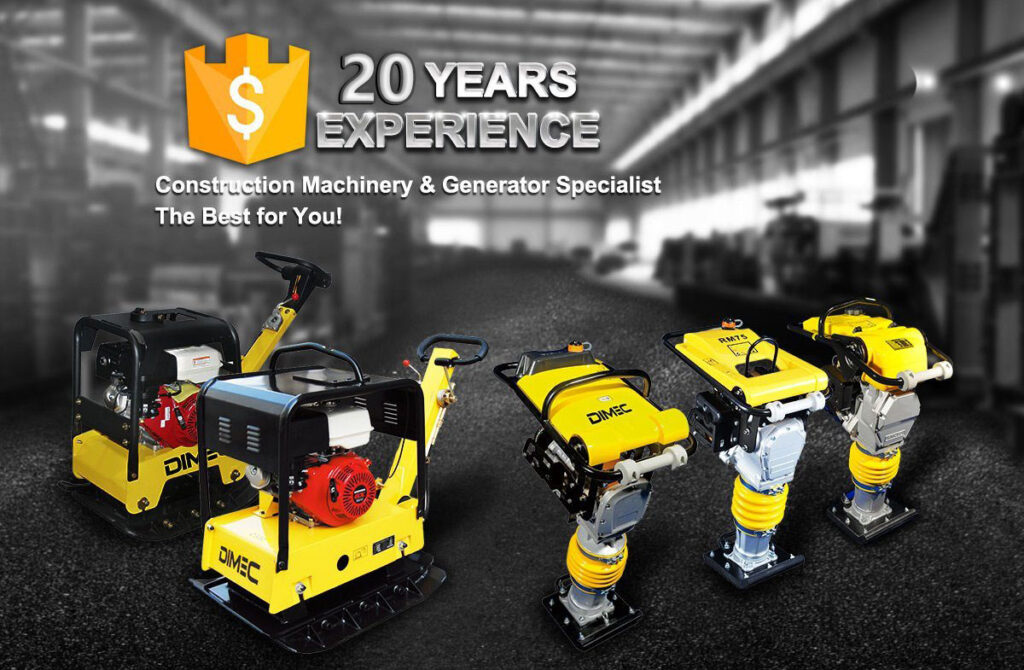Jumping Jack Compactor: Ultimate Guide to Efficient Ground Compaction
- DIMEC
- Jumping Jack Compactor
Home » Jumping Jack Compactor: Ultimate Guide to Efficient Ground Compaction

Table of Contents
Introduction to Jumping Jack Compactors
Ground compaction is a crucial step in construction and landscaping, ensuring stability and durability. One of the most effective tools for this job is the Jumping Jack Compactor. This guide will walk you through everything you need to know about these powerful machines, including their benefits, features, and usage.
What is a Jumping Jack Compactor?
A Jumping Jack Compactor, also known as a ramming compactor or trench compactor, is a construction tool designed to compact soil and granular materials. Unlike plate compactors that use vibration, these machines deliver high-impact force to compress loose soil efficiently.
How a Jumping Jack Compactor Works
Jumping Jack Compactors operate using a percussive motion, generating rapid up-and-down movements that exert significant force on the ground. These machines are typically powered by gasoline or diesel engines, driving an internal mechanism that transfers energy to the footplate.
Benefits of Using a Jumping Jack Compactor
Superior Soil Compaction: Ideal for cohesive soils, such as clay.
Increased Stability: Ensures a solid foundation for roads, sidewalks, and structures.
Easy Maneuverability: Compact size allows use in tight spaces.
Enhanced Productivity: Faster compaction reduces project timelines.
Versatile Applications: Suitable for trenches, backfills, and general construction sites.
Jumping Jack Compactor vs. Plate Compactor
| Feature | Jumping Jack Compactor | Plate Compactor |
| Movement | Vertical, percussive motion | Horizontal vibration |
| Best For | Clay, cohesive soils | Sand, gravel, granular soils |
| Size | Compact | Larger surface coverage |
| Maneuverability | Ideal for narrow spaces | Best for open areas |
Key Features to Consider When Buying a Jumping Jack Compactor
Engine Type – Gasoline or diesel.
Compaction Force – Measured in pounds per square inch (PSI).
Footplate Size – Determines coverage area.
Weight – Affects ease of transport and control.
Vibration Frequency – Higher frequencies improve efficiency.
Top Brands and Models in the Market
Wacker Neuson BS50-2 – Lightweight and fuel-efficient.
Multiquip MTX70HD – High impact force for deep compaction.
DIMEC Series – Reliable and durable.
Proper Usage and Safety Tips
Always wear safety gear (gloves, ear protection, steel-toe boots).
Ensure stable footing before operation.
Keep hands and feet away from moving parts.
Avoid over-compacting in one spot to prevent soil displacement.
Step-by-Step Guide to Operating a Jumping Jack Compactor
Check fuel and oil levels before starting.
Place the compactor on firm ground.
Start the engine and let it warm up.
Guide the machine steadily over the area.
Turn off and store safely after use.
Maintenance and Care Tips for Longevity
Clean air filters regularly.
Check for loose bolts and components.
Store in a dry, covered space.
Perform routine engine maintenance.
Common Issues and Troubleshooting
Engine Won’t Start – Check fuel levels and spark plug.
Weak Compaction Force – Inspect footplate and engine performance.
Excessive Vibration – Ensure all bolts are tightened securely.
Applications of Jumping Jack Compactors in Different Industries
Construction: Soil stabilization for buildings.
Landscaping: Compaction for garden paths.
Roadwork: Strengthening asphalt and base layers.
Utility Work: Backfilling trenches efficiently.
Environmental Impact and Sustainable Practices
Use eco-friendly fuels.
Regular maintenance for reduced emissions.
Optimize compaction techniques to minimize soil disturbance.
Frequently Asked Questions (FAQs)
1. What is the difference between a Jumping Jack and a vibratory plate compactor?
Jumping Jack compactors use a vertical, percussive motion, while vibratory plate compactors use horizontal vibration.
2. Can I use a Jumping Jack Compactor on gravel?
It is best for cohesive soils, but it can work on gravel with proper technique.
3. How often should I perform maintenance?
Regular checks should be done after every 50 hours of use.
4. What is the average lifespan of a Jumping Jack Compactor?
With proper care, these machines can last over 10 years.
5. Are Jumping Jack Compactors safe to use?
Yes, when following safety guidelines and wearing protective gear.
6. How much does a Jumping Jack Compactor cost?
Prices range from $1,500 to $4,000 depending on the model and features.
Conclusion
Jumping Jack Compactors are essential tools for soil compaction in construction and landscaping. With proper usage, maintenance, and safety precautions, these machines provide reliable and efficient results. Whether you’re a contractor or a DIY enthusiast, investing in a high-quality compactor ensures strong and stable foundations for any project.
You May Also Like